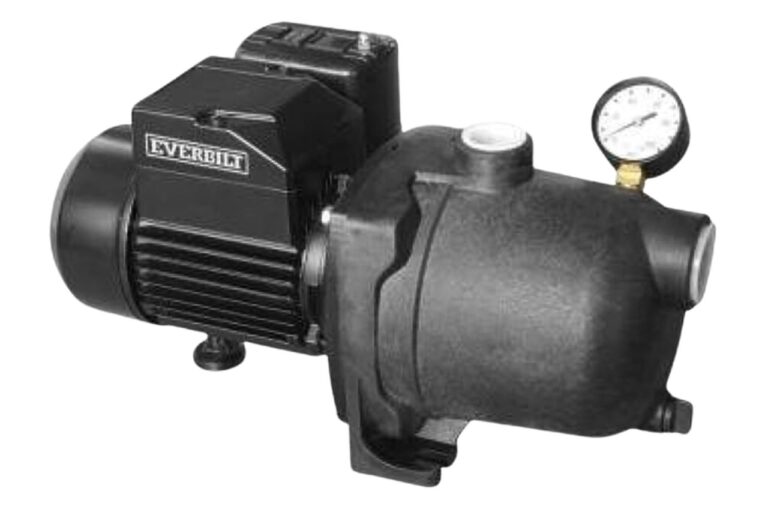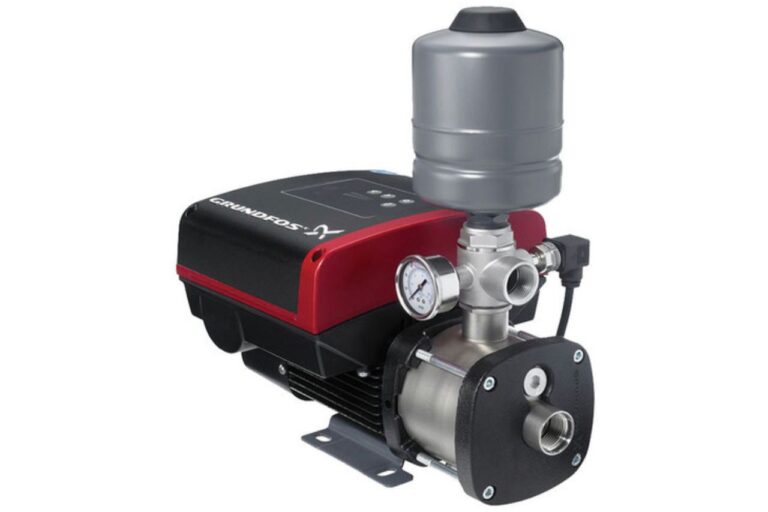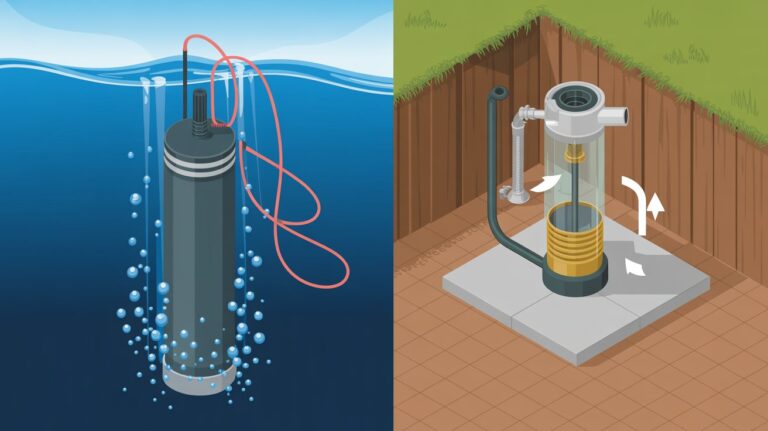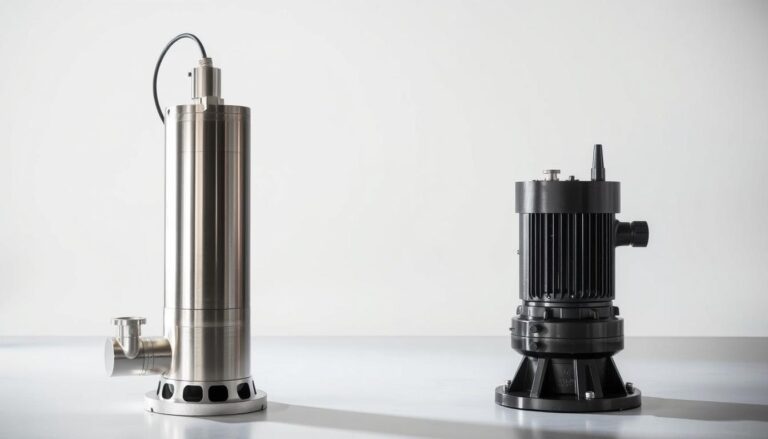Submersible Pump or Sump Pump: Choosing the Best Option
Are you struggling to decide between a submersible pump and a sump pump for your home’s water management needs? Choosing the right pump is crucial for preventing water damage and ensuring a dry basement.
The debate between submersible pump vs sump pump often leaves homeowners confused. While both types of pumps are designed to remove water, they operate in different ways and are suited for different applications.
Understanding the differences between these two pumps is essential for making an informed decision that meets your specific needs.
Key Takeaways
- Understand the primary function of submersible and sump pumps.
- Learn the key differences between submersible and sump pumps.
- Discover the advantages and disadvantages of each pump type.
- Find out how to choose the best pump for your home’s water management needs.
- Explore factors to consider when deciding between a submersible pump and a sump pump.
Understanding Water Pumps and Their Importance
Understanding the importance of water pumps can help homeowners protect their properties from water-related issues. Water pumps are essential for managing water accumulation and preventing flooding in homes.
Common Water Challenges in Homes
Homeowners often face challenges such as basement flooding, water accumulation, and moisture issues. These problems can lead to significant damage and health concerns if not addressed promptly.
How Pumps Protect Your Property
Submersible pumps and sump pumps offer effective solutions to these challenges. By removing excess water, these pumps help prevent structural damage and reduce the risk of mold growth. The advantages of submersible pumps include their ability to operate underwater and handle high volumes of water, while sump pump benefits include their effectiveness in basement flood prevention.
Understanding the differences between submersible pumps and sump pumps is crucial for selecting the right pump for specific needs. Both types of pumps play a vital role in protecting properties from water damage.
What Is a Submersible Pump?
Submersible pumps are specialized pumps that function efficiently when fully submerged in water. They are designed to operate underwater, making them ideal for various applications, including sump pits, wells, and sewage systems.
Design and Construction
Submersible pumps are built with a waterproof seal that prevents water from entering the pump’s electrical components. This design allows them to operate safely underwater. The pumps are typically made with durable materials, such as stainless steel or plastic, to withstand the corrosive effects of water and other substances they may come into contact with.
How Submersible Pumps Work
Submersible pumps work by using a sealed motor connected to the pump’s inlet. When the motor is activated, it drives the pump’s impeller, creating suction that draws water into the pump. The water is then pushed out through the discharge pipe, creating a continuous flow. This process allows submersible pumps to efficiently move large volumes of water.
Common Applications
Submersible pumps are used in a variety of applications, including:
- Sump pits to prevent basement flooding
- Wells and boreholes for water supply
- Sewage and wastewater systems
- Construction sites for dewatering
These pumps are preferred in many situations due to their efficiency, reliability, and ability to operate in submerged conditions.
What Is a Sump Pump?
When it comes to keeping your basement dry, a sump pump is an indispensable tool. Sump pumps are specifically designed for sump pits and play a crucial role in preventing basement flooding.
Design and Construction
A sump pump is typically constructed with durable materials to withstand prolonged submersion in water. The design often includes a float switch that activates the pump when the water level rises. This mechanism ensures efficient operation and helps prevent water damage.
How Sump Pumps Work
Sump pumps work by pumping water out of the sump pit and away from the house. The process begins when water accumulates in the pit, triggering the float switch to turn on the pump. The water is then directed through a discharge pipe to a safe distance from the home, mitigating the risk of flooding.
Common Applications
Sump pumps are commonly used in homes with basements, especially in areas prone to heavy rainfall or where the water table is high. They are also utilized in various industrial settings where water accumulation is a concern. By comparing different types of sump pumps, such as submersible pump vs pedestal pump, homeowners can make informed decisions about their water management needs.
In conclusion, sump pumps are vital for maintaining a dry basement and preventing water damage. Understanding their design, functionality, and applications can help homeowners choose the right sump pump for their specific needs.
Submersible Pump vs Sump Pump: Key Differences
To choose the right pump for your needs, it’s essential to compare submersible and sump pumps. Both are used for water management, but they serve different purposes and have distinct characteristics.
Operational Differences
Submersible pumps operate underwater, directly pumping water from the source, whereas sump pumps are typically installed in a pit and activate when the water level rises. Submersible pumps are designed for continuous operation, making them suitable for applications like sewage and well water management.
Installation Requirements
The installation process differs significantly between the two. Submersible pumps are submerged in the water source, requiring a robust sealing system to prevent water ingress. Sump pumps, on the other hand, are installed in a sump pit, with the pump sitting at the bottom. The choice of installation depends on the specific application and available infrastructure.
| Feature | Submersible Pump | Sump Pump |
|---|---|---|
| Operation | Underwater operation | Installed in a sump pit |
| Application | Sewage, well water, drainage | Basement flooding prevention |
| Noise Level | Generally quieter | Can be noisier, depending on type |
Power and Performance Comparison
Submersible pumps are often more powerful and can handle thicker, more viscous materials, making them ideal for sewage applications. Sump pumps are generally less powerful but are designed for quick water removal in residential settings.
Noise and Visibility Factors
Submersible pumps are typically quieter since they operate underwater. Sump pumps can be noisier, especially if they are pedestal types. Visibility is also a factor, as submersible pumps are hidden from view, while sump pumps are often visible in the sump pit.
Types of Submersible Pumps
The world of submersible pumps is diverse, with different types designed for specific tasks and environments. Submersible pumps are categorized based on their applications, design, and functionality.
Sewage Submersible Pumps
Sewage submersible pumps are designed to handle wastewater and sewage. They are built with robust materials to withstand the harsh conditions of sewage environments. These pumps are crucial for homes and businesses, especially in areas prone to flooding or with septic systems.
Well Submersible Pumps
Well submersible pumps are used for extracting water from wells. They are designed to operate underwater, providing a reliable source of clean water for residential, agricultural, and industrial purposes. The pumps are typically made with corrosion-resistant materials to ensure longevity.
Utility Submersible Pumps
Utility submersible pumps are versatile and used in various applications, including construction site dewatering, pond drainage, and emergency flood response. They are designed for heavy-duty use and can handle a range of water conditions.
Drainage Submersible Pumps
Drainage submersible pumps are used for removing excess water from areas such as basements, ponds, and construction sites. They are efficient and effective, often used in emergency situations to prevent water damage.
| Type of Submersible Pump | Primary Application | Key Features |
|---|---|---|
| Sewage Submersible Pumps | Wastewater and sewage handling | Robust construction, resistant to harsh conditions |
| Well Submersible Pumps | Extracting water from wells | Corrosion-resistant, reliable for clean water supply |
| Utility Submersible Pumps | Various applications including dewatering and flood response | Heavy-duty, versatile, handles different water conditions |
| Drainage Submersible Pumps | Removing excess water from basements, ponds, etc. | Efficient, effective for emergency water removal |
As highlighted by industry experts, “The right submersible pump can make a significant difference in water management and efficiency.” The variety of submersible pumps available allows users to select the most appropriate pump for their specific needs, ensuring effective and efficient operation.
Types of Sump Pumps
Understanding the different types of sump pumps available is crucial for making an informed decision that protects your home. Sump pumps come in various designs, each with its unique features and benefits.
Pedestal Sump Pumps
Pedestal sump pumps are characterized by their motor being mounted above the sump pit, connected to the pump by a shaft. This design allows for easier maintenance and repair. They are generally more affordable upfront but may not be as durable as submersible models.
Submersible Sump Pumps
Submersible sump pumps are fully submerged in the sump pit, offering quieter operation and potentially longer lifespan. They are more efficient at handling water and are less prone to freezing in cold temperatures.
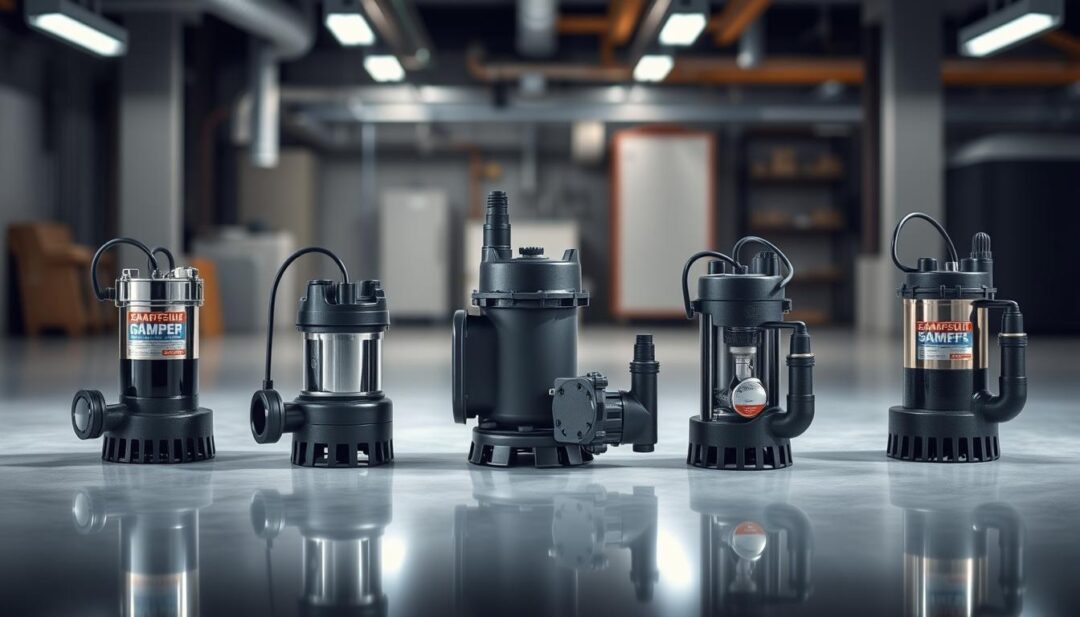
Battery Backup Sump Pumps
Battery backup sump pumps provide an essential safety net during power outages, ensuring continuous operation. They are particularly valuable in areas prone to severe weather conditions.
Water-Powered Sump Pumps
Water-powered sump pumps use the home’s water pressure to operate, offering another reliable backup option. They are ideal for situations where electricity is not available or reliable.
By comparing these types, homeowners can select the best sump pump for their specific needs, balancing factors like cost, efficiency, and reliability.
Advantages and Disadvantages of Submersible Pumps
When considering a submersible pump, it’s essential to weigh its advantages and disadvantages. Submersible pumps are widely used in various applications, including water supply, sewage, and industrial processes.
Benefits of Using Submersible Pumps
Submersible pumps offer several key benefits, including:
- High efficiency and reliability
- Ability to handle high-pressure applications
- Quiet operation due to being submerged
- Corrosion-resistant materials for longevity
These advantages make submersible pumps a popular choice for many users.
Limitations and Drawbacks
Despite their benefits, submersible pumps also have some limitations:
- Higher upfront costs compared to non-submersible pumps
- Potential for increased maintenance due to submerged components
- Limited accessibility for repairs
Understanding these drawbacks is crucial for making an informed decision.
Energy Efficiency Considerations
Submersible pumps are known for their energy efficiency, particularly in applications where they can operate directly in the fluid being pumped. This can lead to significant energy savings over time. However, the overall energy efficiency also depends on factors like the pump’s design, horsepower, and the specific application.
Advantages and Disadvantages of Sump Pumps
Understanding the benefits and drawbacks of sump pumps is crucial for homeowners considering their installation. Sump pumps are designed to remove water that accumulates in a sump pit, typically found in basements, thereby preventing flooding and water damage.
Benefits of Using Sump Pumps
Sump pumps offer several benefits, including effective flood prevention and reduced risk of water damage. By automatically removing accumulated water, they help maintain a dry basement, which is essential for storage and can prevent mold growth. Additionally, sump pumps can be particularly valuable in areas prone to heavy rainfall or where the water table is high.
Limitations and Drawbacks
Despite their benefits, sump pumps also have some limitations. For instance, they require regular maintenance to ensure they function correctly when needed. Failure to maintain a sump pump can lead to mechanical failure during critical periods, potentially resulting in significant water damage. Moreover, the initial installation cost, including potentially complex setup, can be a deterrent for some homeowners.
Space and Accessibility Factors
The installation of a sump pump involves considerations regarding space and accessibility. The sump pit needs to be located in an accessible area to facilitate maintenance and potential repairs. Furthermore, the type of sump pump chosen (e.g., submersible vs. pedestal) can impact the overall space requirements and the ease of accessing the pump for maintenance.
In conclusion, while sump pumps offer significant advantages in terms of flood prevention and water damage mitigation, their effectiveness is contingent upon proper installation, regular maintenance, and consideration of space and accessibility factors.
Cost Comparison and ROI
When deciding between a submersible pump and a sump pump, understanding the cost implications is crucial. The total cost of ownership includes the initial purchase price, installation expenses, and long-term operating costs.
Initial Purchase Costs
The initial purchase cost varies significantly between submersible and sump pumps, largely due to differences in design and functionality. Submersible pumps are often more expensive upfront due to their complex design and higher horsepower capabilities.
Installation Expenses
Installation costs can also differ. Submersible pumps typically require more straightforward installation since they operate underwater, while sump pumps need a pit and sometimes additional plumbing.
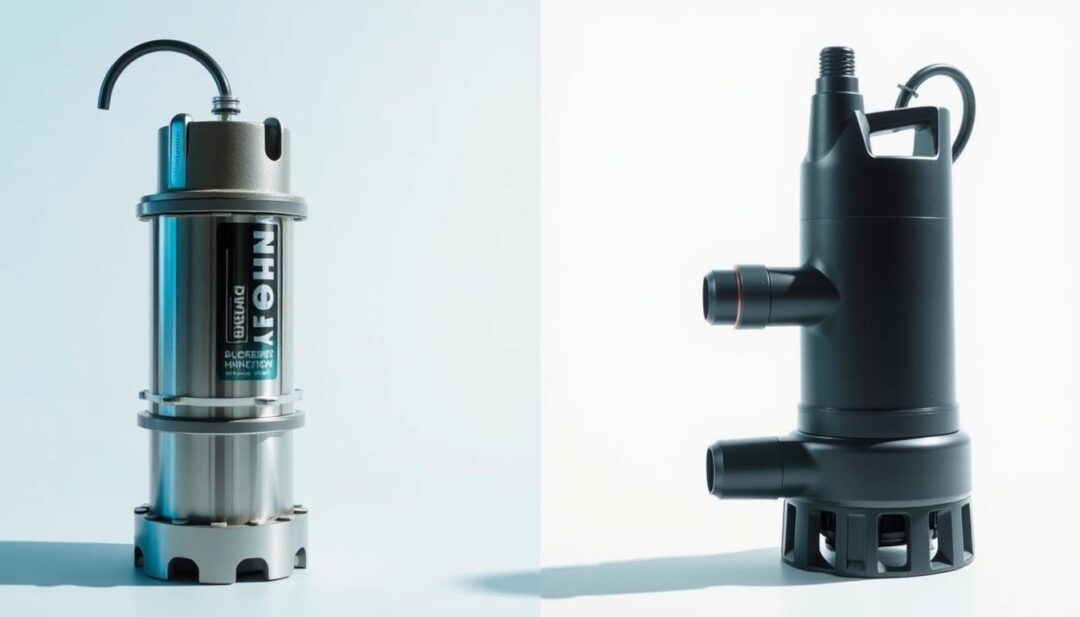
Long-term Operating Costs
Operating costs are influenced by factors like energy efficiency and maintenance needs. Submersible pumps are generally more energy-efficient, potentially lowering long-term operating costs.
Return on Investment Analysis
When evaluating the return on investment (ROI), consider both the initial costs and long-term savings. While submersible pumps may have higher upfront costs, their efficiency and durability can provide a better ROI over time.
- Initial Cost: Submersible pumps are often more expensive.
- Operating Cost: Submersible pumps can be more energy-efficient.
- ROI: Submersible pumps may offer better long-term value.
Installation and Maintenance Guidelines
The installation and maintenance of submersible and sump pumps are critical aspects that determine their efficiency and lifespan. Properly installed and maintained pumps not only perform better but also last longer, providing reliable service and minimizing the risk of unexpected failures.
Installing a Submersible Pump
Installing a submersible pump requires careful planning and execution. It’s essential to ensure the pump is correctly sized for the application and that all electrical connections are secure and meet safety standards. The pump should be lowered into the water or sump pit carefully to avoid damage to the equipment or surrounding structure.
Installing a Sump Pump
Sump pump installation involves selecting the right location for the sump pit, ensuring it’s large enough to accommodate the pump and has adequate drainage. The pump should be installed with a check valve to prevent backflow and connected to a reliable power source. Regular testing after installation is crucial to ensure it’s working correctly.
Maintenance Requirements and Schedules
Regular maintenance is vital for the longevity and effectiveness of both submersible and sump pumps. This includes checking for wear and tear, cleaning intake screens, and testing the pump’s operation. For submersible pumps, inspecting the cable and connections for damage is also crucial.
| Maintenance Task | Submersible Pump | Sump Pump |
|---|---|---|
| Inspect for Wear and Tear | Every 6 months | Every 3 months |
| Clean Intake Screens | Every 3 months | Every 2 months |
| Test Pump Operation | Monthly | Monthly |
Troubleshooting Common Issues
Despite regular maintenance, issues can arise. Common problems include failure to pump, inadequate pumping, and excessive noise. Troubleshooting involves checking power supply, inspecting for blockages, and ensuring the pump is properly sized for the application.
By following these installation and maintenance guidelines, you can ensure your submersible or sump pump operates effectively and reliably, protecting your property from water damage.
Choosing the Right Pump for Specific Scenarios
Understanding the specific requirements of your project or property is key to choosing the right pump. Different applications demand different types of pumps, and selecting the appropriate one is crucial for effective water management.
Basement Flooding Prevention
For basement flooding prevention, a sump pump is often the preferred choice. It is designed to remove water that accumulates in a sump pit, typically found in basements. Sump pumps are effective in keeping the basement dry and preventing water damage.
Well Water Systems
In well water systems, submersible pumps are commonly used. They are designed to be submerged underwater and can efficiently pump water from deep wells to the surface.
Pond and Water Feature Management
For managing ponds and water features, submersible pumps are often utilized due to their ability to operate underwater and circulate water effectively.
Construction Site Dewatering
Construction site dewatering frequently involves the use of submersible pumps due to their capability to handle large volumes of water and operate in challenging environments.
Residential Applications
In residential settings, the choice between submersible and sump pumps depends on the specific needs, such as basement protection or well water supply.
Commercial Applications
For commercial applications, the scale and complexity of the water management needs often dictate the type of pump required. Submersible pumps are versatile and can be used in various commercial scenarios.
| Application | Preferred Pump Type | Key Features |
|---|---|---|
| Basement Flooding Prevention | Sump Pump | Effective water removal, automatic operation |
| Well Water Systems | Submersible Pump | Deep water pumping capability, durable |
| Pond and Water Feature Management | Submersible Pump | Underwater operation, water circulation |
| Construction Site Dewatering | Submersible Pump | High volume water handling, robust construction |
Conclusion
When it comes to protecting your property from water damage,
choosing the right pump is crucial.
The debate between submersible pump vs sump pump highlights the importance of understanding your specific needs.
Submersible pumps are versatile and can be used in various applications, from sewage management to well water systems.
Sump pumps, on the other hand, are designed specifically for basement flooding prevention and are typically installed in a sump pit.
To make an informed decision, consider factors such as the pump’s purpose, installation requirements, and maintenance needs.
By weighing these factors and understanding the differences between submersible and sump pumps, you can select the ideal pump for your specific situation.
This ensures effective water management and helps safeguard your property against potential water damage.


